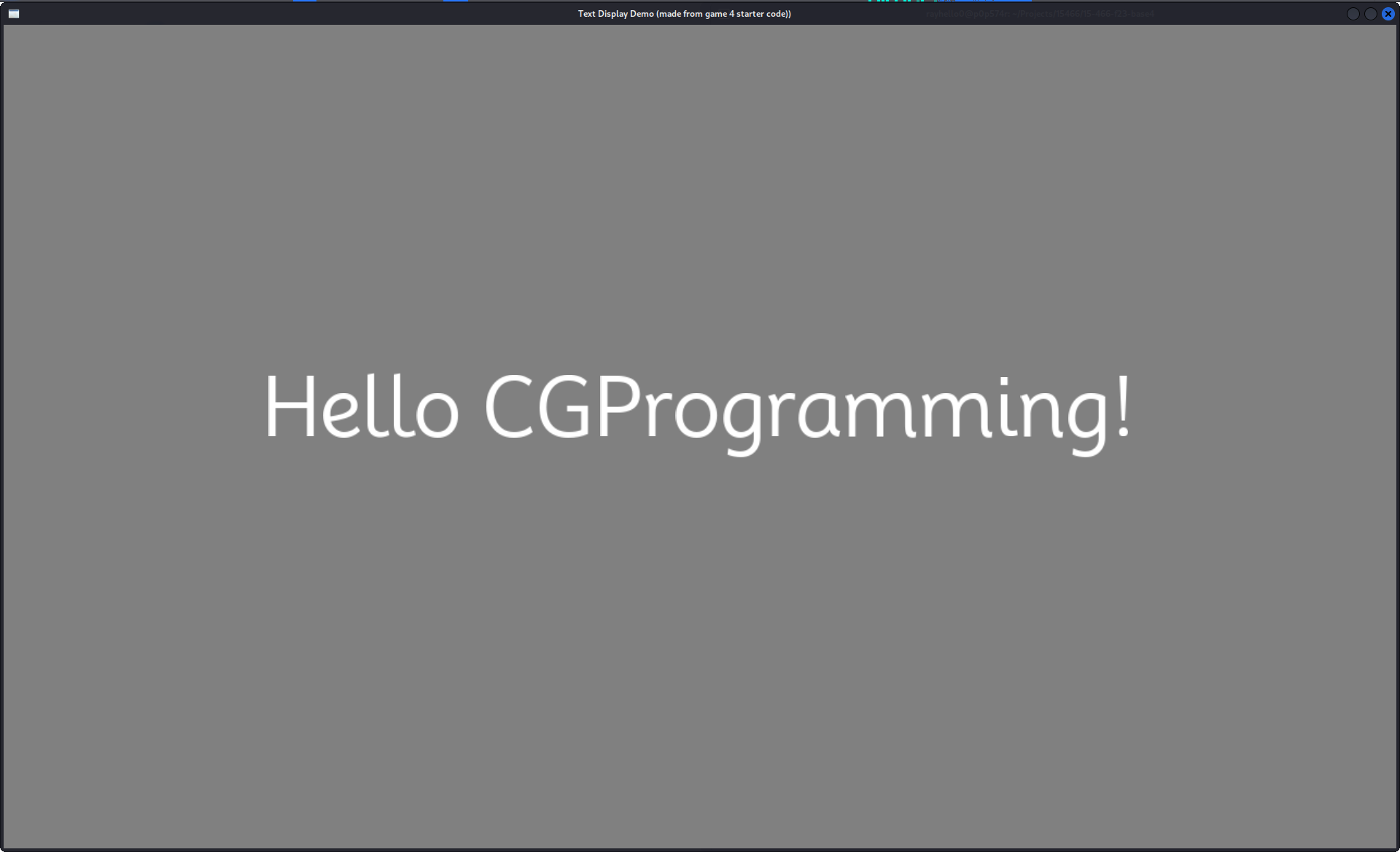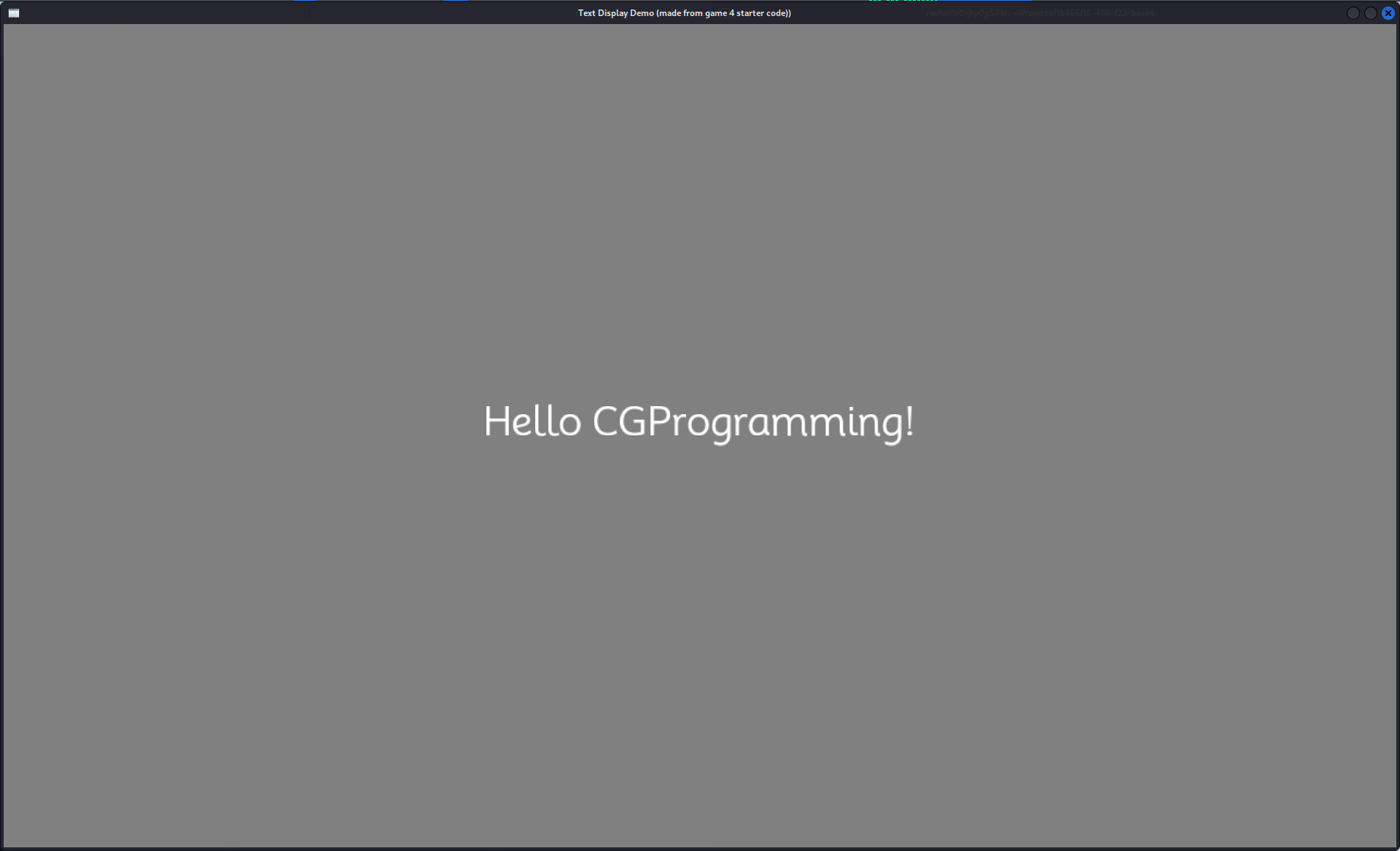Author: Sirui (Ray) Huang (with help from Sizhe Chen) and any sources referenced in the code.
Description:
This text display package is an optimized version of the original text display module created for in 15-466 game4. Functionalities include rendering texts in different fonts, sizes, scales, colors at any position in the drawable space. Compatiblility with Load.hpp is supported. Projection matrix is orthographic, so perspective is not supported.
Please feel free to point out bugs and make changes to this package!
This package contains the following files:
README.md: This document.TextDisplay.hpp: Header file of structTextDisplay.TextDisplay.cpp: Cpp file implementingTextDisplay.ColorTextProgram.hpp: Header file of openGL programcolor_text_program.ColorTextProgram.hpp: Cpp file containing the program specifics.demo_images/: Folder containing demo images forREADME.md.
Text Drawing is realized using HarfBuzz buffers to read FreeType fonts and rendering them using openGL VBO. FreeType reads font and fills in bitmaps for VBO. HarfBuzz buffers provide sizes, advances, and offsets of glyphs, mcuh simplifying the rendering procedure. This process is realized in the newly created utility files TextDisplay.hpp and TextDisplay.cpp, along with the openGL program ColorTextProgram (referenced from OpenGL Text Rendering Chapter).
To use this package, place all four files in the main directory.
In the file where you plan to render text (PlayMode.cpp most of the time), add the line #include TextDisplay.hpp.
Also, add maek.CPP('TextDisplay.cpp') and maek.CPP('ColorTextProgram.cpp') to game_names in Maekfile.js to build correctly.
To create a TextDisplay object with your chosen font, use Load< T >. Below is an example using Mooli.
Load< TextDisplay > text_display(LoadTagDefault, []() -> TextDisplay const * {
return new TextDisplay(data_path("Mooli-Regular.ttf"));
});Now you can call the main display function show_text using test_display:
text_display->show_text("Hello CGProgramming!", drawable_size, -1.0f, -1.0f, 72, 1.0f, glm::vec3(1.0f, 1.0f, 1.0f));Example using NotoSansSC:
Load< TextDisplay > text_display(LoadTagDefault, []() -> TextDisplay const * {
return new TextDisplay(data_path("NotoSansSC-VariableFont_wght.ttf"));
});
text_display->show_text("终有一日双星会临近洛希极限", drawable_size, -1.0f, -1.0f, 72, 1.0f, glm::vec3(1.0f, 1.0f, 1.0f));The font used the following demos is Mooli.
show_text is the main display function. Its declaration is as below:
void show_text(
std::string const &text,
glm::uvec2 const &drawable_size,
float const &x_in,
float const &y_in,
int const &size,
float const &scale,
glm::vec3 const &color
) const;The text you want to display.
text_display->show_text("Byebye CGProgramming!", drawable_size, -1.0f, -1.0f, 72, 1.0f, glm::vec3(1.0f, 1.0f, 1.0f));Pass in the drawable size for your game. It is passed as a parameter in PlayMode::draw.
The position you specify your text to be displayed.
If x_in/y_in is assigned a value no less than 0, the text will be displayed with the assigned value as the starting position to draw.
text_display->show_text("Hello CGProgramming!", drawable_size, 100.0f, 200.0f, 72, 1.0f, glm::vec3(1.0f, 1.0f, 1.0f));If x_in/y_in is assigned a value no less than 0, the text will be dichotomically displayed. See the following examples.
For x_in/y_in, a value of -1.0f will make the text appear at the center.
text_display->show_text("Hello CGProgramming!", drawable_size, -1.0f, -1.0f, 36, 1.0f, glm::vec3(1.0f, 1.0f, 1.0f));If x_in is -2.0f, the text will appear at 1/4 position left of the drawable space.
text_display->show_text("Hello CGProgramming!", drawable_size, -2.0f, -1.0f, 36, 1.0f, glm::vec3(1.0f, 1.0f, 1.0f));If x_in is -3.0f, the text will appear at 3/4 position right of the drawable space.
text_display->show_text("Hello CGProgramming!", drawable_size, -3.0f, -1.0f, 36, 1.0f, glm::vec3(1.0f, 1.0f, 1.0f));-4.0f will be 1/8, -5.0f will be 3/8, -8.0f will be 1/16, etc.
The same logic applies to y_in. y position will go bottom-up as the absolute value of y_in increases before it reaches some power of 2.
text_display->show_text("Hello CGProgramming!", drawable_size, -1.0f, -2.0f, 36, 1.0f, glm::vec3(1.0f, 1.0f, 1.0f));Of course, you can let x_in and y_in be dichotomic at the same time.
text_display->show_text("Hello CGProgramming!", drawable_size, -2.0f, -3.0f, 36, 1.0f, glm::vec3(1.0f, 1.0f, 1.0f));Or mix it up where one of x_in and y_in is absolute position and the other one is dichotomic position.
text_display->show_text("Hello CGProgramming!", drawable_size, -1.0f, 550.0f, 72, 1.0f, glm::vec3(1.0f, 1.0f, 1.0f));Note: If x_in/y_in is assigned a negative float that has digits after the floating point, it will be rounded down (e.g. -3.1415f to -4.0f).
The font size of your text.
text_display->show_text("Hello CGProgramming!", drawable_size, -1.0f, -1.0f, 108, 1.0f, glm::vec3(1.0f, 1.0f, 1.0f));The scale of your text. Note this is different from the font size. The rendered text is scaled with the font size unchanged. If you set scale to a large value, the rendered text will become blurry.
text_display->show_text("Hello CGProgramming!", drawable_size, -1.0f, -1.0f, 72, 1.5f, glm::vec3(1.0f, 1.0f, 1.0f));The color of your text. The color is a glm::vec3 with each component ranging from 0.0f to 1.0f.
text_display->show_text("Hello CGProgramming!", drawable_size, -1.0f, -1.0f, 72, 1.0f, glm::vec3(0.5f, 1.0f, 1.0f));text_display->show_text("Hello CGProgramming!", drawable_size, -1.0f, -1.0f, 72, 1.0f, glm::vec3(0.0f, 0.0f, 0.0f));This package is created referring to the following sources:
15466 game4 base code: https://github.com/15-466/15-466-f22-base4
The online book for learning OpenGL, specifically the chapter on Text Rendering: https://learnopengl.com/In-Practice/Text-Rendering
The code example from learning OpenGL: https://learnopengl.com/code_viewer_gh.php?code=src/7.in_practice/2.text_rendering/text_rendering.cpphttps://github.com/harfbuzz/harfbuzz-tutorial/blob/master/hello-harfbuzz-freetype.c
Harfbuzz manual: https://harfbuzz.github.io/index.html
Harfbuzz Tutorial: https://github.com/harfbuzz/harfbuzz-tutorial/blob/master/hello-harfbuzz-freetype.c
FreeType Tutorial: https://freetype.org/freetype2/docs/tutorial/index.html
Other resources used: Mooli,NotoSansSC.













